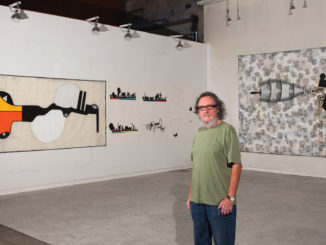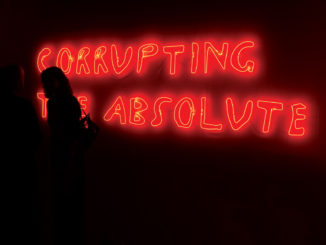Bass Museum of art offers a look at contemporary art
 Back then, John Bass, a talented musician and artist, born in 1891 in Vienna, wanted to study art but his father sent him to business school. After finishing business school, still not convinced it was money he wanted to make, Bass moved in 1914 to New York, where he spent enough time as an unsuccessful pianist to realize his old man might have had a point. Bass then took a job as an errand boy at the Wall Street firm he would later become president of, as the placard underneath the bronze bust of John Bass in the lobby of the museum that bears his name now shows.
Back then, John Bass, a talented musician and artist, born in 1891 in Vienna, wanted to study art but his father sent him to business school. After finishing business school, still not convinced it was money he wanted to make, Bass moved in 1914 to New York, where he spent enough time as an unsuccessful pianist to realize his old man might have had a point. Bass then took a job as an errand boy at the Wall Street firm he would later become president of, as the placard underneath the bronze bust of John Bass in the lobby of the museum that bears his name now shows.
Who knows what would have happened if Bass had stubbornly continued struggling for years as a pianist, maybe there would be a piano bar on the beach with his name on it. Instead, now there is an art museum that hundreds of thousands have experienced since 1963, when Bass and his wife Johanna donated 500 or so works from their collection and along with the money from the City of Miami Beach converted the city’s library and art center into the Bass Museum.
Now, almost 50 years later, Sylvia Karman Cubiña, once a local independent curator, is in charge of the museum that includes 35,000 square-feet of exhibition space, a permanent collection that has swelled to five times its original size, and programs designed to educate and entertain.
“The museum’s mission places people at the center of all activity,” said Cubiña, who took the helm in 2008. “So the scholarship, the art, the cultural activities, the facilities, and the social events are all geared to educate while entertaining. Yes, I used the word entertain, which may surprise some, but I really think that if people do not have a good time, we are failing.”
So it is Cubiña’s task as director to fill the museum’s programming with art classes, classical and jazz performances, wine tastings, and reaching out to local schools to help attract visitors to the space and ultimately the museum’s main attraction: Art.
This was not always the case. During the Renaissance and Baroque periods when much of museum’s permanent collection were created, art was commissioned and admired almost totally by the privileged.
While the way art is supported has shifted to include more public support, artists have always addressed the issues of the day in their work. As support and admiration for the arts has spread to include more of the general public, so has the freedom of expression for contemporary artists.
One of the adjunct curators for the museum, Steven Holmes, says, “All art is contemporary, even art made 500 years ago. All art responds to not just issues of a particular moment but issues that are timeless and responds to issues of artists and human beings of that time.”
One of the first things Cubiña did after accepting the position was to begin working with Holmes, who is the curator for “Human Rites”, one of the museum’s must-see exhibitions this summer, opening June 25th.
The two started working together six years ago when Cubiña was director of The Moore Space. “Sylvia has a background as a well respected curator and director in contemporary art world,” Holmes said. “We thought this would be a fantastic opportunity to bring together traditional and contemporary art.”
“Human Rites” is the second in a series of three shows that make up “Endless Renaissance”, “On Beauty” will follow later this year. Holmes said the idea for “Human Rites” started last year with the notion that things do not change much over time.
“We want to take the collection at the Bass, enliven and reengage it in context of art as an ongoing project,” he said. “’Human Rites’ is a particular version of the way that artists have engaged with ritual, either as subject or artists, creating objects of ritual or the ritual itself. “
For instance one of the forty artists in the show is On Kawara who deals with ritual itself in a piece called I Met. For twelve years, the artist kept a journal of all the people he met and the dates on which he met them in chronological order.
“It’s a minimal description of being human,” Holmes explained. “But it draws attention to the role that ritual inhabits and plays in our lives. Rituals are timeless and universal beyond any particular culture whether it’s church bells, a shaman beginning prayer, or small Hindu ceremonial objects in a temple, these things bring meaning to what we do.”
And while ritual is often associated with religion, Holmes added, that ritual can be as common as watching the news or the playoffs; “Humans everywhere and all times have always had ritual habits and meanings that go behind these things.”
While “Human Rites” includes works and rituals from the middle ages to 2010, the museum’s Egyptian Gallery features the ancient ritual of burying the dead. This spring, the museum opened a permanent Egyptian Gallery, featuring a mummy and coffin, which date back to 760 B.C.
John Bass acquired the sarcophagus and mummy in 1971 from Galarie Fischer in Luzern, Switzerland. According to the gallery, the set came from the collection of Count Franz Erback zu Erbach, among the most important eighteenth-century antiquities collections in Europe.
The museum recruited Dr. Edward Bleiberg, Curator of Egyptian Classical and Ancient Middle Eastern Art at the Brooklyn Museum, as consulting curator of the project to research and interpret the hieroglyphic paintings on the surface of the sarcophagus.
And in what was the first ever collaboration between Mount Sinai Hospital and the Bass Museum, the hospital’s radiology department scanned the mummy, revealing 3-D images of the body of a 30-year-old male who suffered from spinal problems and had great teeth. In addition to the mummy and sarcophagus, the 460 square-foot first-floor gallery includes 14 Egyptian artifacts and long-term loans from the Brooklyn Museum, Lowe Art Museum, and private collections.
In the museum’s Salon of Western Art is where you will find the nineteenth – and early twentieth – century paintings from the collection, evident of Bass’s continued links with his birth country of Austria. The museum has one of the strongest representative collections of Austrian paintings in the United States.
Among notable artists, the museum’s collection includes paintings by Jacob Jordaens, Peter Paul Rubens, Gerard Seghers, Ferdinand Bol, Giovanni Barbagelata, as well as an altarpiece by Italian Renaissance masters Botticelli and Ghirlandaio, one of only a handful of Botticellis on public view in the United States. From 1981 when the museum opened, until 2007, Diane Camber was its only director. By the year 2008 the Bass Museum’s national search for Camber’s successor led to the selection of Sylvia Karman Cubiña, a local independent curator who had gained the respect of internationally known contemporary art collectors, Rosa de la Cruz and Craig Robbins.
The collectors appointed Cubiña as the founding director of their collaborative exhibition space in Miami’s Design District, The Moore Space, now closed, which presented international contemporary art forms through an experimental program of cross-disciplinary exhibitions, performances, artists and curators residencies, and public programs which reflected the state of contemporary art today (an experience that helped prepare Cubiña to maintain the museum’s permanent collection while boosting the museum’s contemporary art reputation). “We want to show great art, but at the Bass Museum, people are always at the center,” Cubiña explained, “so we gear our approach toward making the museum-visiting experience fun.”



Be the first to comment